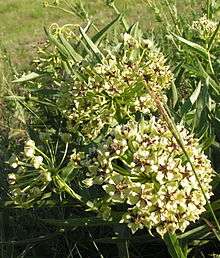Asclepias asperula
Asclepias asperula, commonly called green-flowered milkweed or spider antelope horns,[2] is a species of milkweed native to the Southwestern United States and northern Mexico.
| Antelope horns | |
|---|---|
 | |
| Scientific classification | |
| Kingdom: | Plantae |
| Clade: | Tracheophytes |
| Clade: | Angiosperms |
| Clade: | Eudicots |
| Clade: | Asterids |
| Order: | Gentianales |
| Family: | Apocynaceae |
| Genus: | Asclepias |
| Species: | A. asperula |
| Binomial name | |
| Asclepias asperula (Decne.) Woodson | |
| Synonyms[1] | |
| |
Description
It is a perennial plant growing to 0.3–0.9 m (1–3 feet) tall, with clustered greenish-yellow flowers with maroon highlights. It blooms from April through June.
Taxonomy
Asclepias asperula is divided into two subspecies: asperula and capricornu (also known as var. decumbens), with the latter occurring in moister conditions and having wider leaves. Subspecies asperula occurs in drier and hotter habitat, thus its narrower leaves and lower maximum height.[3][2]
 Subspecies asperula
Subspecies asperula Subspecies capricornu
Subspecies capricornu
Ecology
Like several other species of milkweed, A. asperula is a food for monarch butterfly caterpillars. Along with being a source of nutrition for monarchs, the plants also contain toxic cardiac glycosides (Cardenolides) that the monarchs retain, making them unpalatable and poisonous to predators. For the same reason, A. asperula can be poisonous to livestock and other animals, including humans.
In addition to the monarch, it is a larval host to the dogbane tiger moth, the queen butterfly, and the unexpected cycnia.[4]
This species may require a species of solitary bee that is large and strong enough to be able to pry open its flowers for successful pollination.[5]
Cultivation
In cultivation, this species favors quickly-draining soil that is higher in inorganic matter, such as sand and rock chips. It can grow in loam and clay, if provided with adequate drainage and frequent-enough dryness.[6] Moisture level demands and tolerance depend upon the subspecies and possibly ecotype. The plant has a deep taproot so it needs to have the deepest-possible pot if grown in a container and should not be waterlogged.[6]
References
- "The Plant List: A Working List of All Plant Species". Retrieved 12 April 2015.
- "Asclepias asperula ssp. capricornu". Lady Bird Johnson Wildflower Center. The University of Texas at Austin. 2019. Retrieved 21 January 2019.
- "Asclepias asperula subsp. asperula". The Jepson Herbarium. Regents of the University of California. 2019. Retrieved 21 January 2019.
- The Xerces Society (2016), Gardening for Butterflies: How You Can Attract and Protect Beautiful, Beneficial Insects, Timber Press.
- "Asclepias asperula". Lady Bird Johnson Wildflower Center. The University of Texas at Austin. 2019. Retrieved 21 January 2019.
- "Asclepias asperula — Antelope Horn". Plant Finder. Native American Seed. 2019. Retrieved 21 January 2019.
| Wikimedia Commons has media related to Asclepias asperula. |